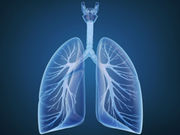Independent correlation for higher doses of ACE, ARBs with slower change in percent emphysema
FRIDAY, March 17, 2017 (HealthDay News) — Use of angiotensin converting enzyme (ACE) inhibitors and angiotensin receptor blockers (ARBs) is associated with slowed progression of percent emphysema on chest computed tomography (CT), according to a study published online Feb. 16 in the Annals of the American Thoracic Society.
Megha A. Parikh, from Columbia University in New York City, and colleagues examined whether ACE inhibitor and ARB dose correlated with the progression of percent emphysema on CT in participants of the Multi-Ethnic Study of Atherosclerosis. Data were included for 4,472 participants
The researchers found that 12 and 6 percent of participants used an ACE inhibitor and an ARB, respectively, at baseline. The median percent emphysema was 3.0 at baseline, and over a median of 9.3 years the rate of progression was 0.64 percent. There was an independent correlation for higher doses of ACE inhibitor or ARB with a slower change in percent emphysema (P = 0.03). The predicted mean increase in percent emphysema was 0.66 percent over 10 years in those who did not take ARBs or ACE inhibitors, compared with 0.06 percent among those who used maximum doses of ARBs or ACE inhibitors (P = 0.01). The greatest magnitude of findings was seen among former smokers (P < 0.001).
“Randomized clinical trials of ACE and ARB agents are warranted for the prevention and treatment of emphysema,” the authors write.
Two authors disclosed financial ties to the biopharmaceutical industry.
Copyright © 2017 HealthDay. All rights reserved.








